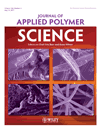Effect of filler on the compression set, compression stress–strain behavior, and mechanical properties of polysulfide sealants
Abstract
In this work, investigations were made on the mechanical properties, stress–strain behavior during compression, swelling and compression set properties of polysulfide sealants at different carbon black and silicon dioxide loadings, and dynamic mechanical thermal analysis was also presented. The results reveal that carbon black filler indeed has significant effects on reinforcing mechanical properties of polysulfide sealants. Increasing carbon black loading improves the tensile strength of sealants promptly, but compression performance increases slowly. The simultaneous use of carbon black and silicon dioxide filler in polysulfide sealants hardly changes the tensile strength of sealants, whereas the ultimate elongation and compression performance of sealants are enhanced remarkably. © 2010 Wiley Periodicals, Inc. J Appl Polym Sci, 2011




